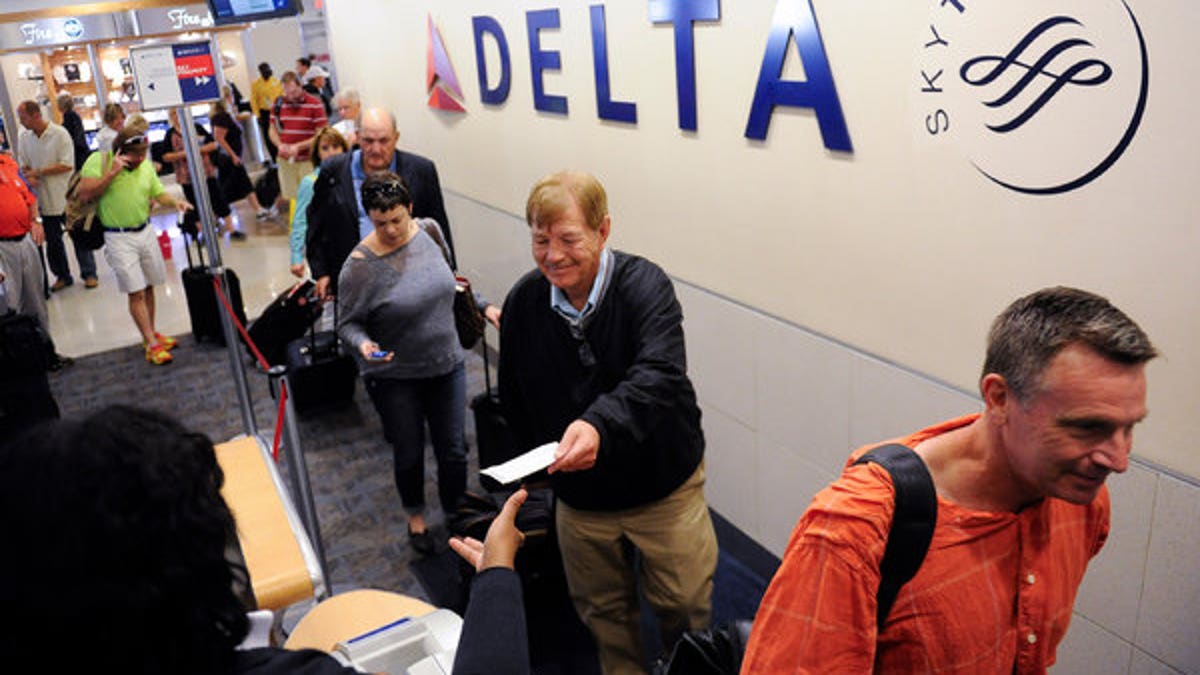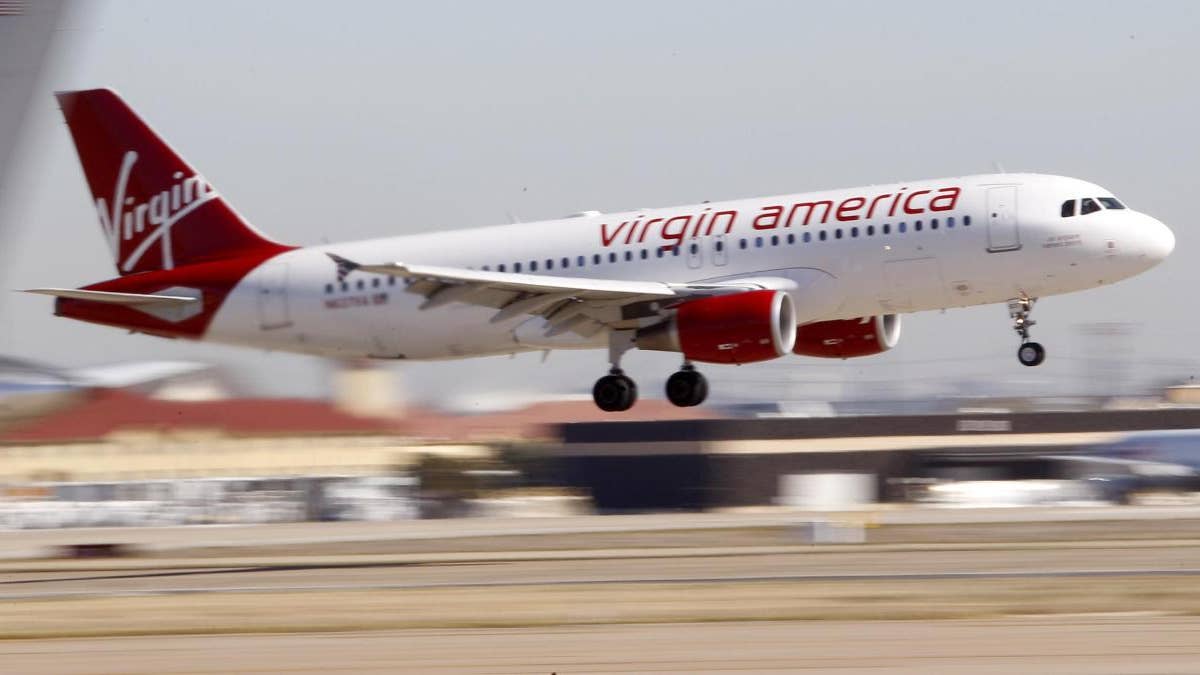
Certain mileage rewards programs let you board first. (AP Photo)
It’s hard to determine the more complicated task: landing a Boeing 787 in 100 mph crosswinds on a short runway with one engine out as someone tickles you — or trying to make sense of airline frequent flier programs.
Frequent flier mileage programs used to be easy: You earned X number of miles, you got a free ticket. Now they’re way more complicated. And unlike in the above scenario, there’s no air traffic control tower to talk you through the process.

(AP Photo)
“It’s getting more confusing to understand how far your miles will take you,” says George Hobica, founder of Airfarewatchdog.com. He says airlines now use a “dynamic model,” where the awards you get for cashing in miles are based on a number of categories, such as how far you’re flying, when you’re flying, the route you’re flying. “If you try to spend miles on Delta, Southwest, JetBlue, or Virgin, they really charge more [miles] for peak holidays, longer flights, and more ideal departure times. The redeye might be cheaper than 5 p.m.”
The result: “You won’t know how many miles you need to redeem until you actually try to book the ticket,” says Hobica.
Redeeming miles isn’t the only thing that’s changed: Airlines are much stingier in awarding them, too. More airlines are awarding tickets based less on how many miles you fly and more on how much you spent for the tickets. “For the majority of travelers, especially those who pride themselves on getting the lowest priced tickets, you’re probably going to come out behind in those programs,” says Brian Kelly, aka the Points Guy.
The only way to navigate these difficult skies, and to land some free flights and/or upgrades, is to educate yourself. So here are 12 things you need to know about frequent flier programs:
1. No two frequent flier programs are alike
“Not all programs are created equal,” says Kelly. “People think airlines are copycats and all their programs are the same, but they’re really not.” So it’s more important than ever to comparison-shop to determine which airline has the best frequent flier program for you. “You have to look at how you spend on travel and where you want to go with those miles and choose the best program for you from there,” says Kelly.
2. The least efficient way to earn miles: flying
If your mileage strategy depends on actually flying to get miles, you’re going to be waiting a long time to earn enough for anything meaningful. “Flying is probably the least lucrative way to earn miles,” says Hobica. “You can earn status that way but not so many miles — unless you fly in business class.”
3. The most efficient way to earn miles: credit cards
“Most airlines now issue more frequent flier miles from credit cards and airline partners than they do from actually flying,” says Brian Kelly. “For people who say, ‘I’m not a frequent traveler,’ that doesn’t mean you shouldn’t have an airline or other credit card.” Kelly’s favorites are Chase Sapphire Preferred (“An all-around solid choice,” says Kelly) and the Citi ThankYou Premier (“The hottest card on the market right now”).
And because the credit card field is so competitive, a lot of them offer generous bonuses just for signing up and spending a minimum amount in the first few months (Citi ThankYou Premier’s bonus is a generous 50,000 points). Says Hobica, “Some of them have no annual fee for one year, so you don’t have to keep it for more than a few months to get the miles.”

Close-up of woman using her smartphone (iStock)
4. Take advantage of your bonus spending categories
Some credit cards give you additional points for each dollar you spend on certain categories (double points for gas, triple points for groceries, etc.). But keep in mind: A lot of these categories are very broad. Take “travel,” for instance — a category in which most credit card programs award additional miles. “‘Travel’ doesn’t just include airlines, hotels, and rental cars,” says Kelly, pointing out that Chase includes in its “travel” category expenditures such as New York City MetroCards, parking, and E-Z Pass.
“I know people pay for their monthly parking, which in New York City can be quite expensive,” says Kelly. “Put that on the right credit card and you’ll be getting double and triple points. Dig deep in the earning categories on your credit cards, because you may find some categories that you didn’t realize.”
5. Shop online the right way
Here’s another way to maximize your credit card points. Major airline and hotel loyalty programs often have online shopping portals on their websites that connect you to certain retailers’ sites. Let’s say you want to buy something from Macy’s. Instead of going to Macy’s.com, you can go to a portal — such as American Airlines’ AAdvantage eShopping — enter in your frequent flier information and click “Macy’s.” It takes you to Macy’s site, where you can shop, sometimes at a discount. And it automatically deposits extra miles into your account (sometimes as many as 10 to 20 bonus miles for each dollar you spend) just for connecting through the airline’s portal. Plus, you get any category bonuses your credit card may assign to certain purchases.
“Even if you see something in the store, sure, go try it on — but then go home and order it online [through the portal],” says Hobica. Kelly agrees: “It’s a no-brainer. Anyone who shops online should be raking in airline miles as well.”
6. Eat your way to more miles
Just like airlines partner with retailers to give you bonus points, same goes for restaurants. “You can sign up for airline dining programs,” says Kelly. “You just attach them one time to your debit or credit card and they automatically give you extra miles and points for dining at certain restaurants. That’s another no-brainer.”

(www.kurtparis.com)
Hobica is an enthusiastic participant. “I have a few restaurants in Los Angeles I really, really like, and they happen to be members of the program,” he says. “You spend 40 bucks and you get 400 miles. You spend 50 bucks, you get 100 miles. It adds up.”
7. Cashing in your miles is getting more expensive
Redeeming your miles is also a strategic dance — and a potentially costly one. “I find that using miles is getting more expensive,” says Hobica. He says the days of a blanket 25,000-mile cost for free domestic tickets, no matter the destination, are long gone: “Now if the airline’s selling a ticket for $800, you’re gonna spend more miles than for the $100 ticket.”
8. Get the most bang for your buck
Experts generally suggest that if possible, don’t cash in your hard-earned miles for a cheap economy domestic ticket. Kelly, for one, says he wouldn’t redeem miles for “a $200 flight to Miami, where it’s not going to have that much of an impact on my budget.” But a $2,000 ticket to Asia is a completely different story — especially if you can also upgrade. “I would say save up for the big trip,” says Kelly. “The longer the trip, generally the better value you’re going to get out of miles, especially in business or first class.”
9. Use ’em or loose ’em
While you should spend your miles carefully, don’t be too miserly. “I tell people not to be hoarders,” Kelly says. “In general, miles lose value over time. Use them before they become less valuable.”
10. Look at partners
Airlines have formed all kinds of partnerships and alliances with other airlines. So when it comes time to redeem your miles, it might be cheaper to cash them in with a partner airline than with the airline where you actually banked them. “Delta’s partnered with Virgin Atlantic,” Kelly says. He then puts forth a hypothetical scenario: “You go on Delta.com trying to fly to Europe, and Delta flights might cost you 250,000 miles. But if you can find business class on Virgin Atlantic, that’s only 125,000 miles.” Kelly admits it may not make sense that airlines would make it cheaper for mileage holders to fly with their partners. “But that’s just the way it is,” he shrugs. He suggests even if you can’t find any partnerships online, you should call up the airlines to see if there’s any partnership availability.
11. If necessary, dump your airline’s frequent flier program
Just because they’re technically loyalty programs, your loyalty should have its limits. “Consumers need to vote with their wallets,” says Kelly. “When airlines make negative changes — when they charge you fees, and you’re not happy — then support another airline. You’ve got to reward the carriers that give you the most for your money.”
12. Remember: Frequent flier programs aren’t charity to customers
Airlines don’t have these frequent flier programs out of the goodness of their hearts. “Frequent flier programs are often the most profitable parts of the company,” says Kelly. “The airlines make billions selling them to credit card companies and partners. [These programs] are probably one of the most effective marketing tools ever invented.”
So don’t act as if the airlines are doing you a favor by giving you miles; at redemption time, demand what’s yours. “Consumers need to realize this is not the airlines being nice — ‘Let me give you a free flight,’” says Kelly. “When it comes time to redeem miles, it’s OK to demand that the airlines make good on their promise.”
More from Yahoo! Travel
How to Stay on Vacation Forever—These People Did It
These Are the 10 Cutest Creatures in Namibia
